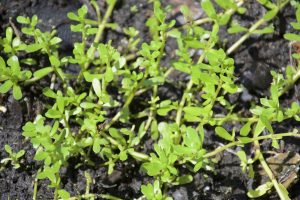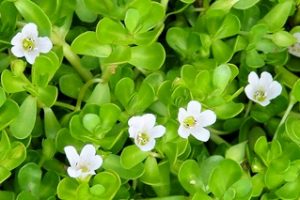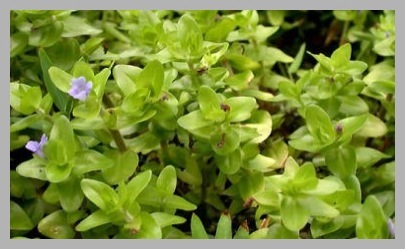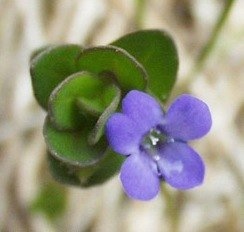Lemon Bacopa, a misnamed edible native with a bitter relative
Call me cranky, but I think Lemon Bacopa has the wrong name.
And, since it is wrongly named and no one comments on that, it also makes me think that those who talk about the plant have never met it in person. It is difficult for me to believe that anyone who has ever smelled the plant would call it “lemony.” One writer did say it smelled like Eucalyptus, which I don’t agree with, but at least he smelled it and agreed it was not “lemon” in odor.
Lemon Bacopa clearly smells of crisp, fresh limes, which is far more fruity than lemons. The tea it makes tastes like limes. Chew a little. It tastes like lime. Rub it on you. People will call you “Limey.” It should be called Lime Bacopa.
One doesn’t see “Lime Bacopa” in the wild too often. It’s usually one of those thing you notice while looking for some other plant, but there it is, forming a thick patch of succulent looking little plants, smelling of LIME when you step on them. What one does find far more often is its cousin, Bacopa monnieri, (buh-KOH-puh mon-ee-ER-ee ) which looks quite different, but with no LIME aroma, or lemon odor or eucalyptus ordor for that matter. In fact, the non-scented Bacopa monnieri, doesn’t even smell green.
Also known as Blue Water-hyssop, the LIME Bacopa can be found in coastal states from Maryland to Texas, though I have always found it inland in semi-wet places, like wet ditches next to dry roads through low woods or shady fields. It likes it wet and can grow and flower totally submerged. This is probably why it is a big hit with the aquarian crowd. Personally, I’ve never seen it in an aquarium, but then again, I’m not a fish nor do I raise them. I do eat them, however. I’ve never seen Lemon Bacopa submerged, or even standing in water. I’ve always found it in damp, rich-soil swales, creating a dense mat.
For such a little plant it has a long nomenclature history. It’s botanical name is Bacopa caroliniana (buh-KOH-puh kair-oh-lin-ee-AY-nuh.) The species name means “from Carolina” “Bacopa” is the Latinized name the aboriginals Indians called it in what is now French Guiana. However, the story does not end there. It is also called the Blue Hyssop. It got that name because a close relative, the B. Monnieri, is called the Water Hyssop. It got its “hyssop” name from a plant in the Bible that had nothing to do with water at all….. now doesn’t that make sense….
In the Bible a plant was called esov or ezon. The Greeks 3,000 years ago called it ussupos (said EE-see-pos.) In Old English it became ysopo, ysope, ysop, isop and then hyssop. Esov was probably Origanum syriacum, or Syrian oregano, which, incidentally, is often mixed with sumac berries (see the article on Sumac.) The Syrian oregano has been collected in bundles since Biblical times as incense to anoint and purify alters. That practice was carried over into the various forms of Catholicism but not as bundles of incense but the holy water sprinkler priests carry, called a hyssop. Hyssop went from a bundle of spice to a water sprinkler to the name of a plant that likes water. Now you know. But, how did they get from a plant that grows in dry areas in the Middle East to one that grows in damp areas in the New World as far as naming goes? The Syrian oregano was associated with the calming of ritual. The water hyssop was known for its calming effects and was the called Herb of Grace. So it got the term “hyssop” as did its cousin the Blue Hyssop, or Lime Bacopa. Monnieri honors Louis Guillaume le Monnier, 1717-1799, French botanist and royal physician to Louis XV.
To make “lemon” bacopa tea crush a few leaves little and put it in hot water.

Research shows Bacopa monnieri can resolve memory problems. Photo by Green Deane
I mulled a long time whether to include Bacopa monnieri on the site as it is more a medicinal herb than a wild edible. It has such good research behind it leaving it out would seem to be a disservice. Basically Bacopa monnieri — Water Hyssop — promotes the growth of nerve endings. It also interacts wtih dopamine and serotonergic systems and is not only anti-inflammatory but an antioxidant (a good reason to take it other than when you are exercising. Taking antioxidants, for example, after weight lifting can reduce the effects of the lifting.) In a double blind Australian study they gave 65-year-olds with cognitive and executive disfunction 300 mg of dried Water Hyssop for three months. They had dramatic and permanent improvement. There was no change after five weeks so long-term use seem necessary.

Bacopa monnieri can have four or five petals.
Research in India and elsewhere also shows Water Hyssop improves memory in adults without memory problems. I personally know people it has help in regards to getting their memory back to being reliable and far less failures of short-term memory. Water Hyssop has also been shown to improve memory and hand-eye coordination in children ages six to eight. Taking Bacopa monnieri extract for five months also prevents epileptic seizures in some people. And animal studies show it reduces stress. Side effects seem to be limited to an upset tummy if taken on an empty stomach. So, why haven’t we heard of Bacopa monnieri? Pharmaceuticals can’t make huge profits off it and despite the research the medical community essentially ignores it. Sold as Bacopa it is found in health food stores, or, in warm areas of the world you can find it in damp spots.
Green Deane’s “Itemizing” Plant Profile Lemon Bacopa
IDENTIFICATION: Small, creeping, three to six inches high, forms patches, blue flowers, lime scent when leaves are crushed… some say lemon. … rough to the touch. Leaves half inch long, alternate around stem, flowers can also be white, four or five petals
TIME OF YEAR: Year round in Florida, flowers all year.
ENVIRONMENT: Likes it wet but seems to grow better when not underwater. Likes full sun but can tolerate some shade. I’ve always seen it in damp but not flooded swales. It can also probably be found in aquarium stores and can be bought over the internet. But, make sure it was raised in wholesome water.
METHOD OF PREPARATION: Tea: Fresh leaves in hot water.
HERB BLURB
The Bacopa caroliniana and Bacopa monnieri have “brahmine and bacco-side.” These have been used as nerve tonics regarding mental disorders. They have also been used for psychosis.




looks alot like purslane… as for the herb blurb, got IPUAC names? i have access to databases as a student….odd bit of knowledge that’d be
Is the bacopa plant suitable for adding raw to salads?
It’s relative, the water hyssop is, but I’ve never read anything about eating Lemon bacopa.
How do you eat it? the leaves, roots, stems, flowers?
Usually it is made into a tea.
I think but I figured out what it truly smells like it smells like lavender with a tiny hint of lime!
I ordered some from Home Depot years ago for my Koi Pond. It tries to take over! It also has survived hard freezes.